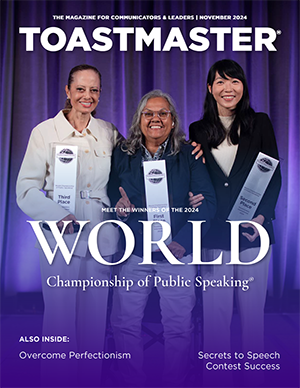
High Performance Leadership
I loved the article in the September 2016 issue about advancing your skills with a High Performance Leadership project. District 31 recently created an HPL committee to raise awareness of, and provide support for, HPL projects at the club, area, division and district levels as well as in the broader community. The HPL program is a remarkable opportunity for any Toastmaster, regardless of skill level, to discover and develop their leadership potential, to receive supportive feedback and encouragement, and to bring together a team to make a valuable contribution to the community. Toastmasters is “Where Leaders Are Made,” and we are eager to fulfill on that promise by partnering with other districts and members, so please reach out to us!
Noj Zachariah, CTM
Framingham-Natick Toastmasters
Natick, Massachusetts
Beyond the Meeting
If you are attending Toastmasters meetings just to attend Toastmasters meetings, you are missing the point. As one of our members says, “You don’t come to Toastmasters meetings to be better Toastmasters. You come to Toastmasters meetings to be better at something else.” Your “something else” is specific to you—and you can apply it to your world outside of Toastmasters.
Each club leadership position provides us an opportunity to learn how to be, for example, a president of a company or a human resources employee. Each functionary role (grammarian, Ah-Counter, timer, etc.) gives us the opportunity to learn what words to use and what words not to use, how to schedule meetings, and more. At your next meeting, watch everyone’s behavior and decide who you would want working for your company. Hopefully one of them is you.
Richard Erschik, ACB, CL
Homestead Toastmasters
Homestead, Florida
I Object!
As a student of Robert’s Rules, I object to John Cadley’s allegedly humorous article (“Robert’s Rules,” September) regarding the portrayal of RONR [Robert’s Rules of Order Newly Revised] and the importance of its role in the conducting of business within deliberative assemblies. For a reader not otherwise familiar with the “rules,” he did a great deal to scare that individual away from wanting to study more about RONR and/or how it can benefit them in the organizations they belong to.
Instead of promoting the overridingly positive aspects of Gen. Robert’s tome, and the use of these rules by people within democratic organizations, Mr. Cadley’s sardonic stance perpetuates the perspective that rules of order (such as Robert’s, Mason’s, Demeter’s et al.) are something to be laughed at, mocked, ridiculed and avoided at all costs.
Let’s hope the meetings Mr. Cadley attends are as cacophonous, confusing and confrontational as his condescending attitude toward order and discipline appears to be. The rest of us will continue to behave in a civil manner.
David Meigel, ACB, ALB
Foothill Toastmasters
Roseville, California
What's in a Word?
Depending on your preferred source, Oscar Wilde, George Bernard Shaw or Winston Churchill spoke of division by a common language. Sometimes, however, one single word, rather than a whole language, will suffice. For instance, U.S. resident Ravikanth Ponnapalli (“Get Your CC Before the Final Countdown,” September) advises us to envision ourselves as “glib and fluent” speakers. Here in England, being “glib” is not a virtue—it connotes someone who is smooth-talking but insincere, shallow and even likely to be dishonest.
What’s in a word? Rather a lot!
Gordon Thompson, CC, CL
Purley Speakers
Purley, United Kingdom
A Fresh Approach
I read Craig Harrison’s article on brainstorming in the April edition with great interest. You see, when I was in college I was able to hear a lecture by one of brainstorming’s conceptual founders. I am glad to see the concept is still being used. One thing Mr. Harrison did not mention is that brainstorming sessions must be kept short. The maximum time for a brainstorming session is between 15 to 20 minutes. Anything longer and it can turn into mental torture. Also, expect that most of the ideas will come within the first 10 minutes—after that, the frequency of ideas will diminish.
Otherwise, it was an excellent article, and the sidebar on more brainstorming techniques presented fresh ways to approach it. Nice job, Mr. Harrison. I hope to see more on this subject in the future.
L. Cooke, CC
Professional Women Toastmasters
Playa Vista, California
Do you have something to say? Write it in 200 words or less. Send us your name, member number and home club. Please note: Letters are subject to editing for length and clarity, and may be published in both the print and electronic editions.



 Previous
Previous
 Previous Article
Previous Article